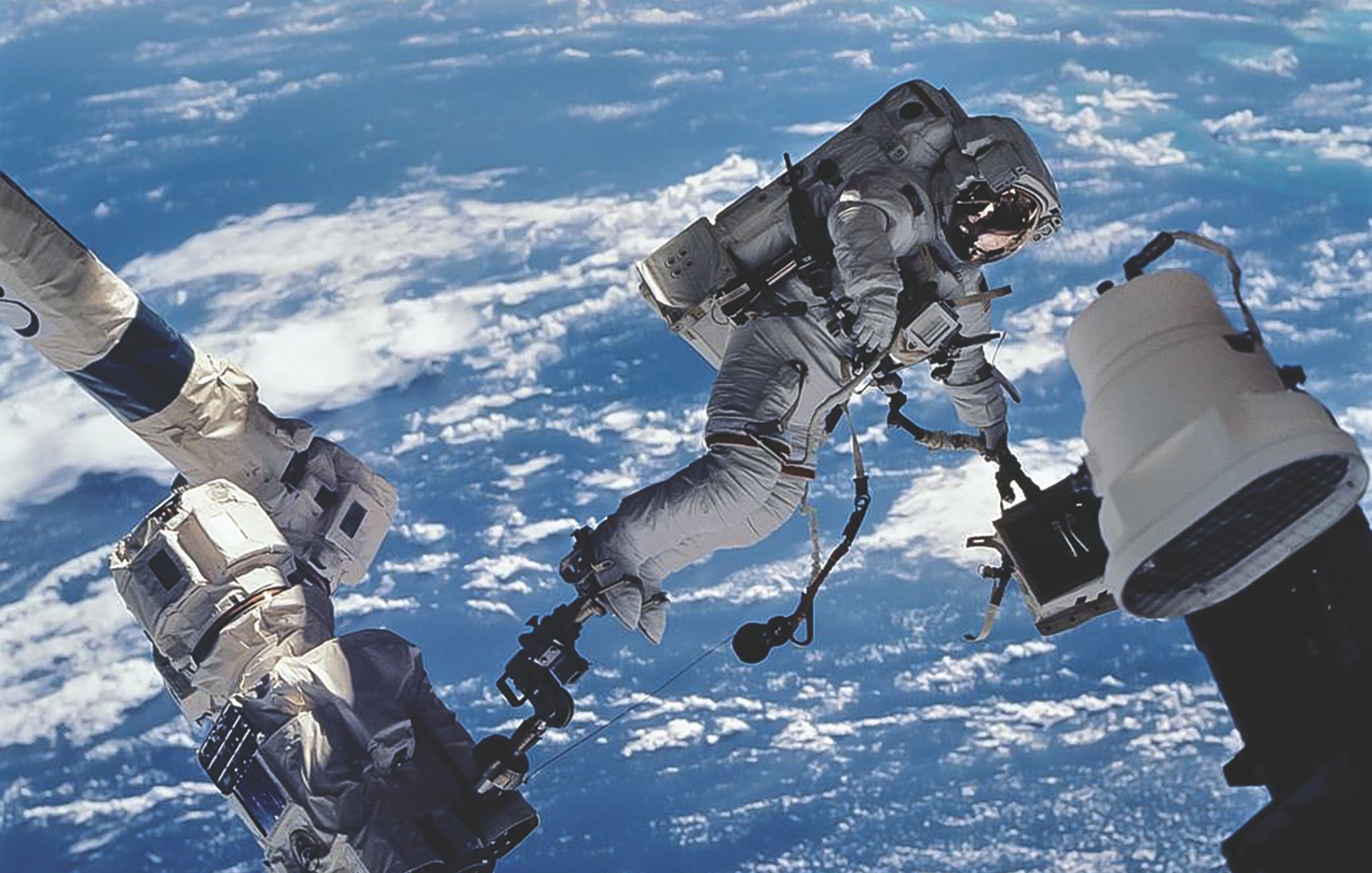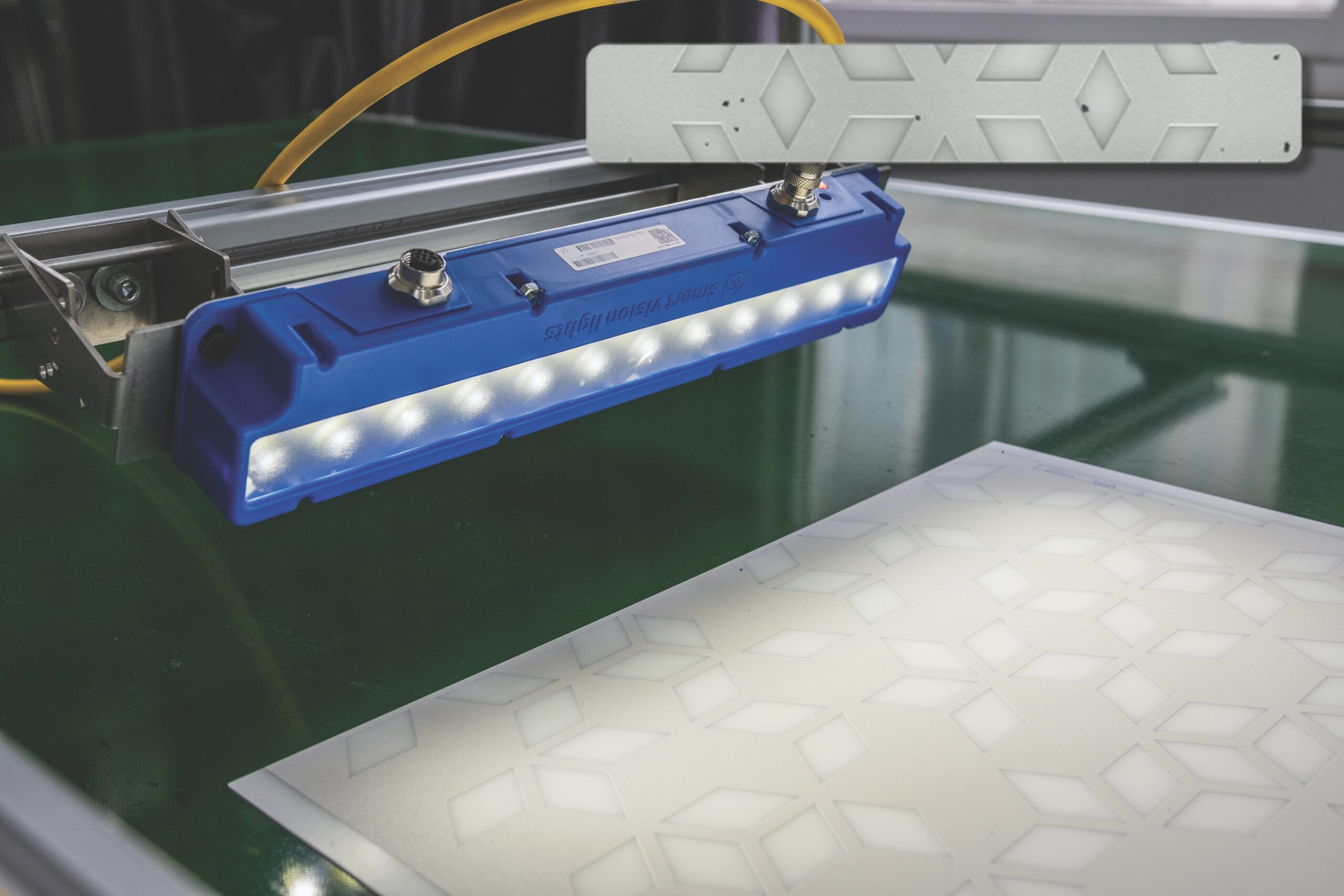Tucked into museums, private collections, and even archaeological sites are some nondescript tubes with bubbly, blemish-filled glass inside. Though it would be easy to write off the old instruments as unimpressive, the assortment of these strange devices scattered over Europe represent some of the world’s earliest known telescopes—the first instruments people used to bring stars, planets, and outer space closer to home, even if only for an evening.
The oldest telescopes available today date to the early- and mid-17th century, not long after the technology itself was born (Figure 1).1 And even though it took a while for telescope users to focus the tubes on the skies—the earliest versions were meant for surveying landscapes and monitoring enemies as they approached—glass has been integral to the collecting and focusing of light as long as the devices have been around.
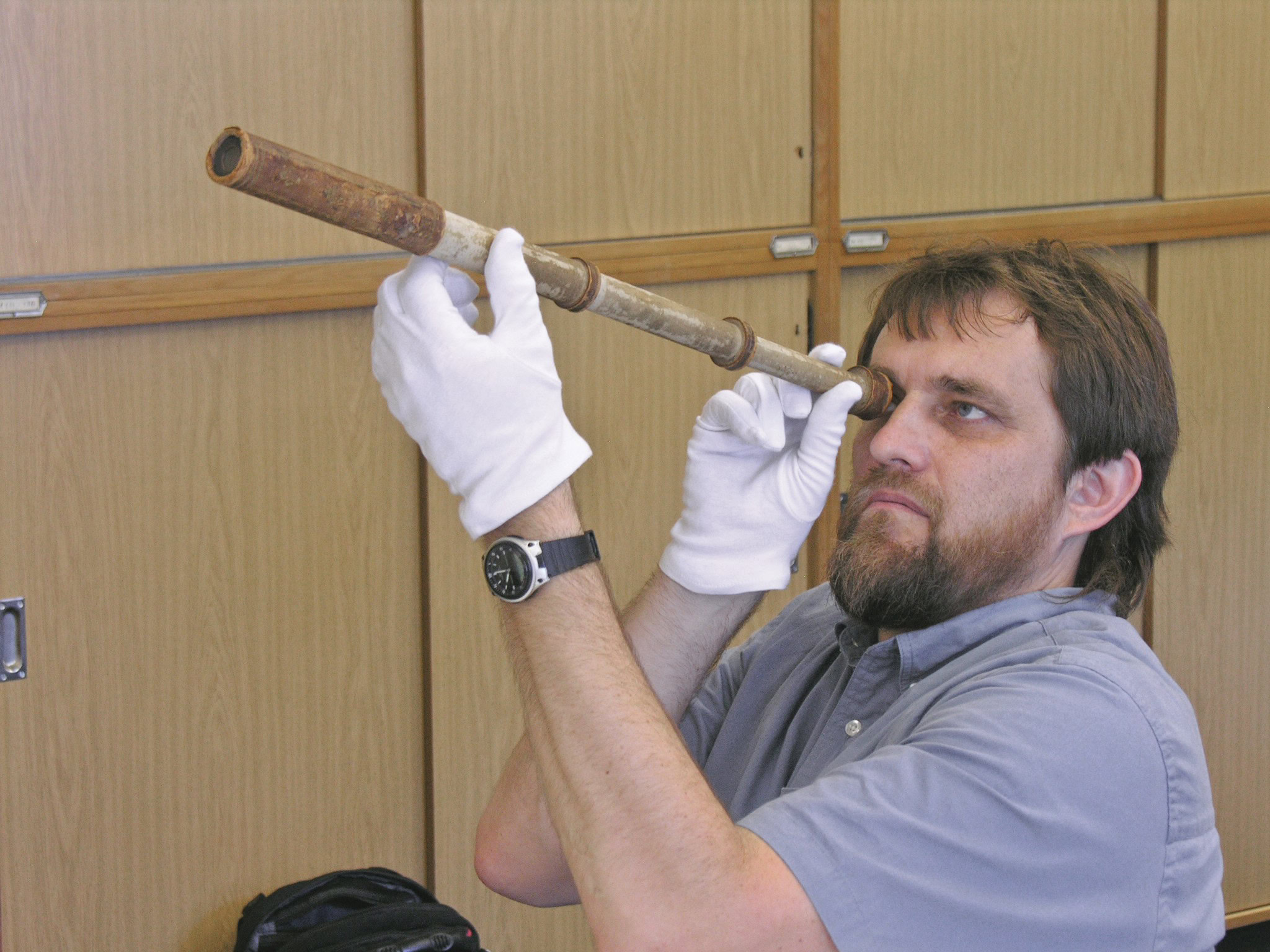
Figure 1. Marvin Bolt, first-ever curator of science and technology at The Corning Museum of Glass before his retirement in 2020, peers through an early telescope made around 1650 CE. The telescope is part of the Astronomisch-Physikalisches Kabinett collection in Kassel, Germany. Credit: Michael Korey
The earliest iterations were full of imperfections from inconsistent raw materials and rudimentary processing situations. Glass quality did not see a significant boost until the late 1600s with leaded varieties, which fostered mass production of telescopes. Lens design and glass types continued to evolve, eventually leading to borosilicate compositions, which still features in the world’s largest and most ambitious space exploration projects.2
Even as we venture into space instead of only watching it from home, glass and the exploration of our universe have stayed inextricably linked. Ceramics, too, have wound their way into the technologies that get us closer and closer to the rest of our universe due to their ability to withstand the extreme environments found in space.
Temperatures in space run a range that is difficult to comprehend—spots near the poles of the moon can drop to –424°F or –253°C,4 while reentering the Earth’s atmosphere can generate temperatures over 4,800°F or 2,649°C.5 A mission and all of its precious cargo must handle temperature changes within this spectrum, all while withstanding battery from other destructive forces.
For example, in low-Earth orbit, which extends about 1,000 kilometers off Earth’s surface,6 the atmosphere consists of about 96% atomic oxygen.7 These highly reactive single oxygen atoms can erode spacecraft exteriors, and so pose a threat to the satellites located in low-Earth orbit, as well as the International Space Station (ISS). Radiation exposure is an issue as well, both in Earth’s immediate area and deeper into space. Over time, cumulative bombardment by high-energy subatomic particles can wear down equipment.8 If a particle strikes an electrical circuit just right, computers and communication systems can crash.
For all that space can throw at a mission, glass and ceramics handle the hazards well. Ceramics are often good insulators and can protect internal heat-sensitive materials and instruments. Additionally, many glass and ceramic materials have good thermal stability, meaning there is minimal expansion, contraction, or warping when they undergo extreme temperature shifts. Both also are fairly chemically stable and can withstand atomic oxygen and radiation better than, say, aluminum9 or silicon.10 Plus, in the vacuum that is space, materials can outgas, meaning molecules come off and drift away. Overall mass drops, and the particles could land on instruments aboard the craft, clouding operations. Glass and ceramics largely resist this kind of vacuum-induced loss.
Glass and ceramics also hold strong appeal in the space industry for a seemingly-minor but fairly important reason: The materials have a long track record. Research and design for space missions is expensive and time-consuming. Whatever goes past Earth’s atmosphere must endure every condition it might meet and, in many cases, needs to ensure the wellbeing of human passengers.
“People who design space vehicles are fairly conservative for obvious reasons,” says Sylvia Johnson, retired chief materials technologist for the Entry Systems and Technology Division at NASA Ames Research Center, in an interview. “If a material has been proven not just by testing but by [for example] landing on Mars, that gives a lot more confidence.”
Glass has hundreds of years of proven space imaging utility. And when it comes to launching equipment into space, use of ceramics to mitigate high temperatures has a history stretching back to 1981, when the Space Shuttle first launched. Portions of the craft that saw the highest temperatures were protected by ceramic tiles designed by University of Washington engineer James Mueller and his team. (Apollo mission heat shields had fiberglass-reinforced epoxy components, where the epoxy composite was designed to ablate away as it deflected heat from the astronauts during reentry.11)
For all these reasons, glass and ceramic materials frequently have a place in space exploration from beginning to end—from launch and return, to all the travel, data collection, and learning in between (Figure 2).

Figure 2. Glass and ceramic materials play a role in space exploration from beginning to end—from launch and return to all the travel, data collection, and learning in between. Credits: Offworld exploration–Thomas Cizauskas, Flickr (Public Domain); International Space Station–NASA Johnson, Flickr (CC BY-NC-ND 2.0); Satellites–Rawpixel; Exit and reentry from space–Official SpaceX Photos, Flickr (CC BY-NC 2.0); Ground-based observations–Pachango, Wikimedia (CC BY-SA 3.0)
Looking beyond our atmosphere: Ground-based telescopes
Though telescopes have progressed from the warped, speckled tubes of several centuries ago, the instruments—whether on land or in the skies—still rely on glass. The material provides an ultrasmooth, durable mirror blank for metal coatings, such as aluminum, that collect light in the telescope. The seven 27.5-foot-diameter blanks making up the primary reflector in the Giant Magellan Telescope (GMT), for example, are made of E6 low expansion borosilicate glass.12
Not only is borosilicate glass relatively affordable compared to other glass options for the project, but it can withstand chemical erosion. Every few years, the telescope lenses for the GMT will get new aluminum coatings to make sure the reflective surface is in good condition. Removing the remnants of the previous coating calls for strong acids and bases to dissolve it away. Borosilicate glass can handle the chemical exposure.
The assembly of each mirror starts with the Ohara Corporation glass manufacturer shipping lumps of the glass from their production site in Japan to the University of Arizona’s Richard F. Caris Mirror Lab. There, the research team selects which glass blocks to melt into a honeycomb-shaped mold. The hexagonal pattern, which is reinforced by silicon carbide bolts, means the final product is a fraction of the weight of a traditional solid-glass mirror. Once in place on the GMT—a project projected to cost $1 billion dollars13—the mirrors will help produce images with 10 times the clarity of the Hubble Space Telescope from the Las Campanas Observatory in the Chilean Andes.14
Glass-ceramics, a newer class of materials, are also making their way into telescopes. Across the Atlantic in Germany, Schott is manufacturing a suite of 949 hexagonal mirror blanks using its trademark ZERODUR glass-ceramic for the European Southern Observatory’s Extremely Large Telescope (Figure 3),15 which will sit in the Atacama Desert, also in Chile.16 Mirror production started in 2020 and will extend into 2024. Before making their way to the $1.3 billion dollar telescope, the glass-ceramic hexagons will go to Safran Reosec for polishing.
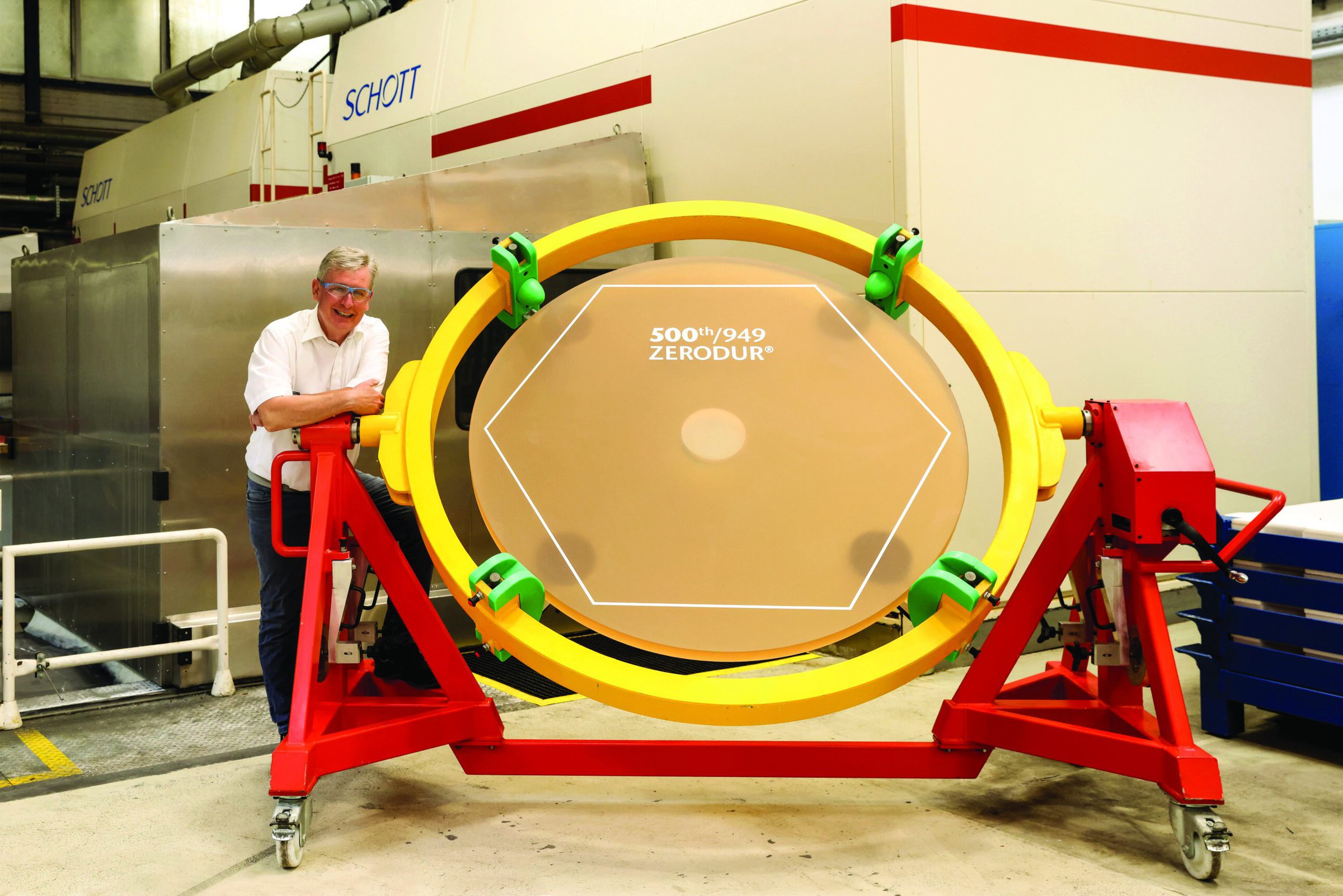
Figure 3. Thomas Werner, head of the Extremely Large Telescope project, pictured with the 500th ZERODUR mirror blank for the M1 primary mirror. Credit: SCHOTT
3, 2, 1…Launching into space
When it comes to getting a spacecraft through the atmosphere and back again, ceramics are core to the heat-protective elements.
“If we’re talking about something that’s intended to be reused with little or minimal TPS [thermal protection system] refurbishment, then we’re looking at ceramic-based systems, almost universally,” says Marc Rezin, senior project manager on NASA’s Artemis and Orion programs, in an interview.
Some of what is in use today is an evolved version of the rigid ceramic tiles that coated parts of the Space Shuttle, with new renditions including alumina fibers as well as the silica fibers that were in the original shuttle ceramics.
Ceramics also withstand impacts from debris better than other thermal protection systems, which is why ceramic tiles are on the back shell of the Orion spacecraft. The craft is not designed for multiple trips. But Rezin and his colleagues chose ceramic tiles for the back half of Orion because the material can withstand encounters with micrometeoroids—a meteoroid fragment smaller than a grain of sand17—and space debris from defunct, human-made objects (Figure 4).
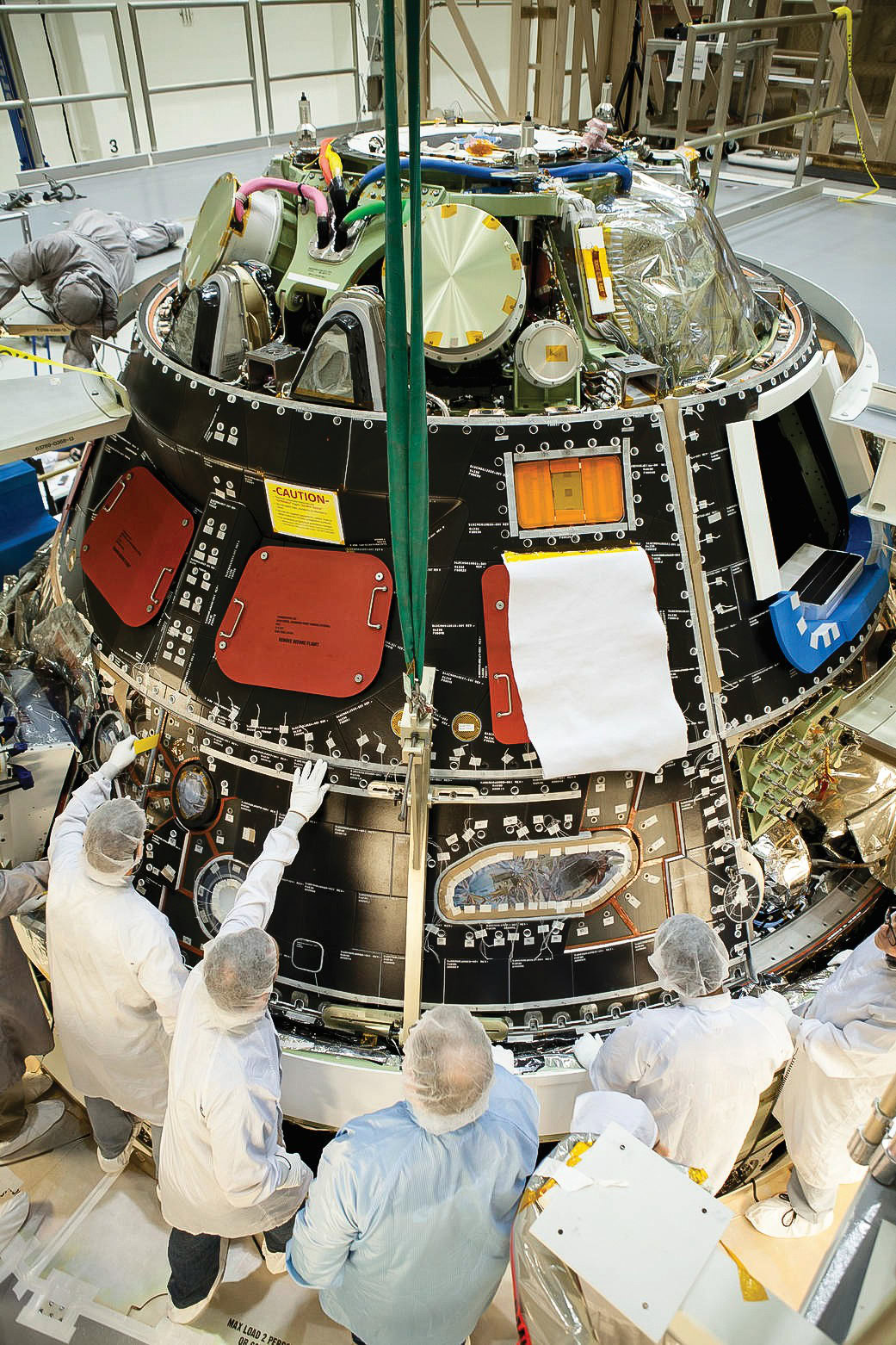
Figure 4. Inside the Operations and Checkout Building high bay at NASA’s Kennedy Space Center, technicians dressed in clean-room suits have installed a back shell tile panel onto the Orion crew module and now are checking the fit next to the middle back shell tile panel. Credit: Dimitri Gerondidakis, NASA
It might seem counterintuitive to praise the durability of a material that is typically thought of as brittle and could be susceptible to crack propagation, Rezin says. But in space, the collisions occur at such high speed, the porous portions of a ceramic thermal protection system take in the energy of collisions and the cracks do not spread like they would in other settings.
“The rigid fiber-based tiles are pretty darn good at absorbing the micrometeorite hits,” Rezin says. As the sheer volume of debris in space continues to grow, there is a chance for ceramic protection systems and their ability to withstand strikes to grow in popularity too, he adds.
The Space Shuttle tile technology also helped inspire a new ceramic-based TPS called TUFROC that “is like a Space Shuttle tile that can go to an even higher temperature,” says Jay Feldman, high-temperature reusable materials project manager at the Thermal Protection Systems branch of NASA Ames, in an interview.
TUFROC, which is used on the leading edge of the wings of the Space Force’s X-37B vehicle,18 has two layers: A shuttle-like tile sits below a composite material made of a silicon oxycarbide matrix with embedded carbon fibers. The carbon-heavy outside reradiates heat while the underlying tile insulates whatever material it covers.19
Oftentimes, the composite is capped with a black glass made of tetraboronsilicide and borosilicate glass.20 A range of surface treatments between the composite and the glass ensure that the thermal expansion of the two materials more closely align. Without those coatings, the glass could pop off with enough use or thermal shock, Feldman says.
Though TUFROC has a complex production process, it is generally easier to fabricate than carbon-carbon composites or carbon-silicon carbide. It has already started to be adopted by companies , for example, Boeing; a derivative is in use by the Sierra Nevada Corporation.
As corporate interest in TUFROC shows, a growing private space industry also means that reusable ceramic thermal protection systems are seeing an increase in demand. Companies around the world are developing reusable mission equipment. Tokyo-based ispace wants to land its first moon lander by the end of 2022 and eventually shuttle materials between the moon and Earth.21 Meanwhile, SpaceX’s HLS Starship was chosen last year by NASA to bring astronauts from the Orion spacecraft to the moon and back using a system that is meant to eventually become reusable.22
Those hoping for cost-efficient shields on their reusable spacecrafts get help from Feldman and AMA Incorporated research scientist Adam Caldwell. Feldman and Caldwell help private industry get a handle on what thermal protection systems are available, how to access them, and, if need be, how to manufacture them.
Currently, a fair number of companies are asking the last question—how to make their own ceramic TPS—because sourcing TPS components has become increasingly challenging. A given tile might have alumina fibers, silica fibers, and aluminum borosilicate fibers.
“Actually turning [the fibers] into a porous ceramic tile is not trivial, and there’s a very limited number of places where they can do that successfully,” Feldman says. “There are not enough sources and given the growth in the industry, it’s become very difficult for folks to source these materials.”
Besides thermal protection systems, ceramics have an important role in the support structure beneath rockets. Concrete is the standard launch pad material. A version called Fondu Fyre, produced by Allied Mineral Products, served as the basis for Kennedy Space Center’s Shuttle Launch Pads 39A and 39B,23 which launched missions ranging from Apollo to the Space Shuttle.24
Though the Fondu Fyre has since been removed, NASA used another concrete-based pad for a new launch complex built at Kennedy in 2020, the first new one built since the 1960s (Figure 5).25 Along with a four-foot-thick concrete pad, Launch Complex 48 includes a small basin to capture water from a sound suppression system and an area where fuel tankers containing propellants can be stored on site. The pad was specifically designed to host a wide range of different propellant types—a feature that caters to commercial spaceflight.
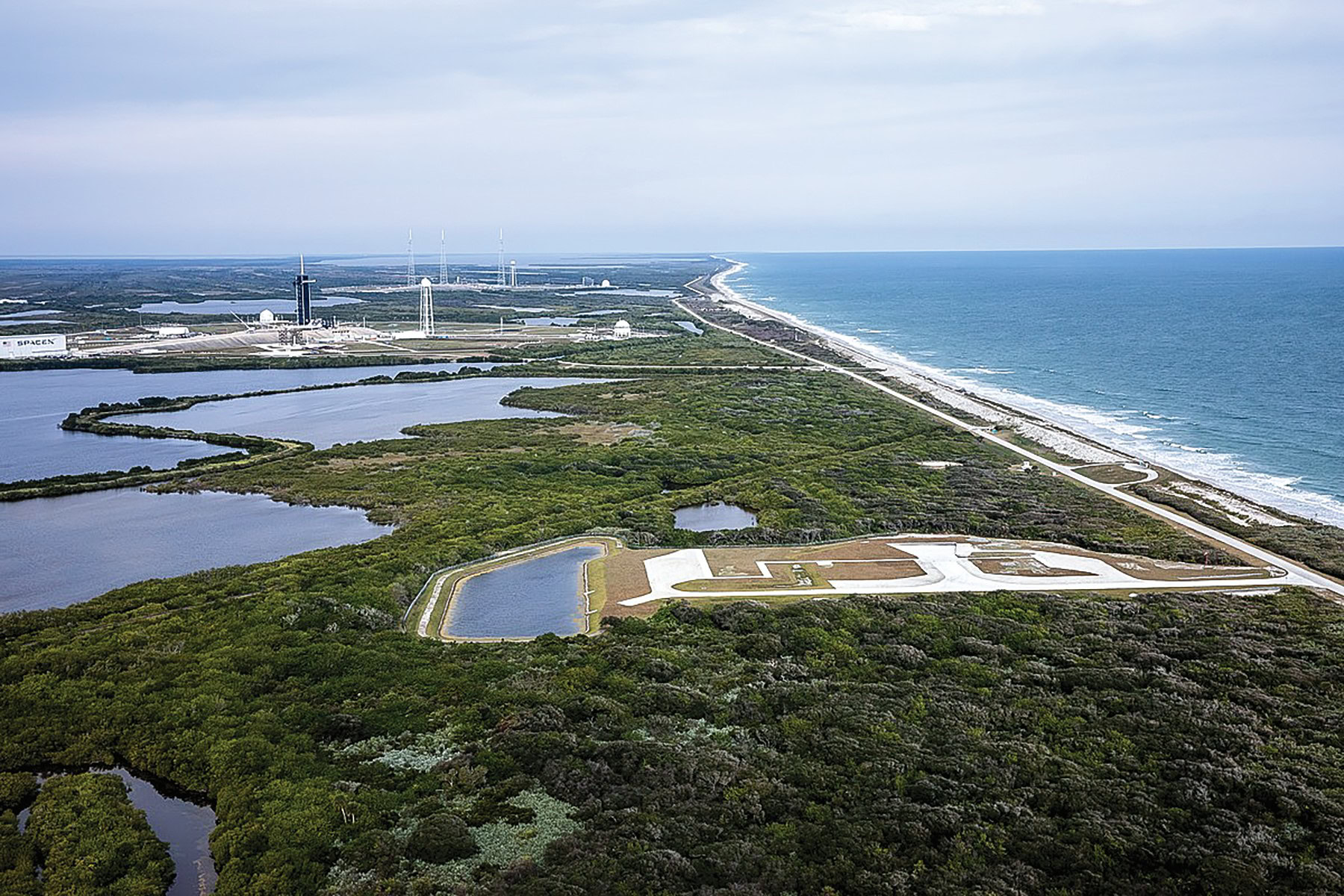
Figure 5. Aerial view of the Kennedy Space Center Launch Complex 48. Launch Complexes 39A and 39B are both visible behind the pad. Credit: Ben Smegelsky, NASA
For decades, NASA experimented with Martyte, an epoxy with embedded ceramics, as a thermal protective coating on launch pads. Even in the 1960s, Martyte held appeal for the way the resin burned away and kept the launch surface cooler in the face of extreme heat from rocket exhaust.26 As recently as 2020, SpaceX also relied on Martyte as a protective covering for underlying concrete pads.27
At least one company turned to graphene to make launches possible. Orbex, a launch service company with offices in the U.K. and Denmark, developed a reusable launch vehicle where the main structure and its tanks are a carbon fiber and graphene composite.28 The relatively small system—62 feet tall and can carry a payload just shy of 400 pounds—should take off for the first time from the company testing site in Scotland later in 2022.29
Safety and operations in space
After launch, mission equipment still relies on glass and ceramics for durability, protection, and the key instruments needed to execute the program goals.
Durable materials protect key components
Though space machinery includes everything from helicopters to space vehicles, satellites are the devices that market analysts predict will drive most of the coming growth in the aerospace ceramics sector.3 More specifically, versions meant to look back at Earth for data collection on weather, agriculture, water, and other planetary systems will see the largest increase in deployments.
Satellites, which stay closer to home and provide services for humans on Earth, are growing in popularity. OneWeb plans to offer global internet access with a network of 648 already launched low-Earth orbit satellites, while SpaceX’s satellite internet service, Starlink, is available in 32 countries.30 Some of these satellites—and the equipment used to get them in orbit—turn to glass-fiber (GFRPs) and carbon-fiber-reinforced polymers (CFRPs).
At Beyond Gravity, the space-oriented segment of the Swiss technology group RUAG, both materials are popular for crafting lightweight but durable space structures. The company produces payload fairings (the protective elements around a spacecraft payload that pop off at the final destination) for clients such as rocket manufacturer United Launch Alliance. They also make satellite bodies and dispensers, which is a sort of tube that carries multiple satellites at once and releases them into orbit.
Beyond Gravity already made CFRP-based dispensers for aforementioned OneWeb and recently signed a contract for a similar order that is reported to be the largest so far for the company.31 Beyond Gravity will make satellite dispensers for Amazon’s Project Kuiper, which also aims to create broadband access via a net of satellites around the world.
To balance weight and durability in their products, Beyond Gravity often manufactures structures with a kind of CFRP sandwich. Thin layers of the composite material house an inner substance, often aluminum, shaped into a honeycomb. Aluminum is a more affordable material compared to CFRP, but the latter material provides enough stiffness that the company can trust products like a dispenser will hold onto its cargo until the exact right moment. The stiffness also means the company can scale up the length of a dispenser fairly easily with CFRP and accommodate a larger number of satellites, says Luca Luzzatto, materials and processes engineer with Beyond Gravity, in an interview.
The company also can trust that the CFRP will not expand or contract severely as products cycle through temperature extremes during deployment, such as from –150°C to 150°C. GFRPs can also work well for parts of equipment where radiowaves need to be transmitted through the craft exterior, Luzzatto says.
Repeatedly manufacturing CFRPs for space equipment requires product control. Inspections—some physical, some chemical, some destructive, and some simply observational—ensure that batches of CFRP are up to standard and not struggling with defects, such as pockets of included air or foreign objects stuck in the composite. With each batch that is made, Beyond Gravity will create designated testing samples for more invasive inspections, such as the compression strength of the product or its tensile properties. If the ordered product happens to need bits cut away for, say, doors or other openings, the team will apply the same tests to the scraps as well because they are part of the larger CFRP pieces that will go to customers. The team will also examine the CFRP interior via ultrasound to see if any empty areas are in the polymer and to generally make sure the entire composite is homogenous.
Satellite missions that go farther and for longer may demand materials designed for longer-lasting durability, says Adrian Tighe, senior materials and processes engineer in the Directorate of Technology, Engineering and Quality at the European Space Agency, in an interview. Ceramic coatings are a popular form of protection against changing temperatures and the space environment as a whole.
Tighe worked on BepiColombo, a two-satellite system that will arrive at Mercury in 2025. For this and other systems like the ESA Solar Orbiter heading toward the sun, extreme heat could melt a craft body made of aluminum. Thin spray-on ceramic coatings, provided by companies such as Germany-based CeraNovis or U.S.-based Cerakote, tolerate the temperature changes better and protect the underlying materials (Figure 6).

Figure 6. Close-up of a set of thrusters on the BepiColombo Mercury Transfer Module that will carry the two science orbiters—the Mercury Planetary Orbiter and the Mercury Magnetospheric Orbiter—to the innermost planet. The silver/white thermal blanket is covered with Nextel, a ceramic cloth known for its heat-resistive properties, which will allow the thrusters to be exposed directly to the sun. Credit: European Space Agency
On BepiColombo, a white ceramic layer covers the craft’s antenna and edges of the solar array to help deflect solar radiation. The coating, which consists of a water glass binder, alumina, and hexagonal boron nitride mix developed by Ceranovis GmbH, required nearly two years of testing to ensure it would not crack and would retain the reflective white color, Tighe says. Tests included ultraviolet light exposure and time in a vacuum chamber oven. Mirrored glass can also serve as a guard against rising temperatures—panels of the material on the side of a craft reflect solar radiation and radiate heat.
Solar power is a primary power source for spacecraft,32 and glass plays a crucial role in these components. Borosilicate33 and aluminosilicate34 glasses still dominate coverings for solar panels, often enhanced with cerium or cerium dioxide to protect solar cells from electron, proton, and ultraviolet radiation.35 The doping with other species also can keep the glass from growing darker over the course of a mission, Tighe says. Excelitas is one of the few manufacturers of cerium-doped coverglass.
Gallium arsenide is another dependable solar cell material for space applications because the material absorbs a wider bandwidth of light and is more resistant to gamma radiation. The Hubble Space Telescope received GaAs solar cells in 2002, as did the Orion spacecraft and the Mars helicopter Ingenuity. This last craft has GaAs solar panels from SolAero Technologies,36 which is now owned by EMCORE RocketLab. The parent company still makes GaAs solar arrays for satellite, along with Nano Avionics.
Advanced materials keep operations running
Aboard spacecrafts, ceramics have found their way into the electronic components. Ever since the Apollo era,37 silicon chips have been the go-to circuitry option for space missions. But silicon has its limits, and increasingly far-flung missions are pushing them. Typically, silicon stops working as a semiconductor around 250°C and, therefore, needs enclosed spaces on a craft that shield the electronics from high heat. Though space agencies successfully designed silicon chips for Mars missions in the past, space environments like that of Venus—which reaches 460°C and includes sulfuric acid clouds that are tens of kilometers deep38—are beyond the abilities of silicon.
Gallium nitride-based materials, on the other hand, could open new avenues in space applications. GaN can handle a wider range of temperatures and often needs less active cooling compared to silicon devices. Plus, GaN is inherently radiation-resistant (though how it withstands radiation is still not completely understood).39
Despite some unknowns concerning GaN durability, ESA plans to use GaN in several upcoming projects. GaN circuits will be used in the Hisdesat telecom satellites launching in 2023 and 2024.40 The Biomass satellite, launching in 2023 to conduct a census of all trees on Earth, will feature GaN-based radiofrequency amplifiers. Two companies—United Monolithic Semiconductors and OMMIC—have made ESA’s European Preferred Part list for manufacturing GaN circuits and semiconductor processes.
Silicon carbide could one day work its way into spacecraft circuitry as well. NASA’s Glenn Gas Sensors team and Glenn Physical Sensors team expect the temperature and radiation-resistant nature of silicon carbide will lead to future electronics that need less protective equipment.41 Reducing weight dedicated to temperature control reduces the launch cost—or, alternatively, increases the number of instruments that can fit on a given satellite.
In 2017, the Glenn Research Center reported testing the first silicon carbide circuit that could withstand Venus-like conditions without any protective or temperature-controlling equipment (Figure 7).42 The chip lasted nearly 22 days inside the Glenn Extreme Environments Rig,43 an apparatus that simulates the heat and pressure environment of Venus. The experiment only ended because other planned work forced the lab to shut the rig down. A research team at the KTH Royal Institute of Technology also assembled several prototype versions of silicon carbide circuits and showed they can operate at 500°C.44

Figure 7. Integrated silicon carbide circuit before (above) and after (below) testing in Venus atmospheric conditions. Credit: NASA
Typically, a spacecraft also carries aboard lenses and other optical equipment. While a smaller satellite with a shorter lifespan might opt for straightforward lenses like what is used on Earth, radiation-resistant glass that will not take on a brown tint during a mission is the current standard material for most advanced systems.
“If it’s a billion-dollar mission, it’s worth getting a more resistant glass,” Tighe says.
This “rad-hard” glass is offered by Schott as well as the Ohara Corporation. Optical benches—the bars that support cameras and lenses within a telescope—are often made of ceramic, for example, silicon carbide and silicon nitride. The extreme thermal stability of the ceramic keeps the mounted instruments steady, leading to higher-resolution measurements from the equipment.
There are some unexpected uses for ceramics in mission technologies as well. The ESA Aeolus satellite, for example, emits laser pulses to create a Doppler effect, measuring how long it takes the light bursts to come back to the device for a sense of how wind and moisture is moving in the atmosphere. The laser pulses are magnified by optical lenses in the satellite, with one of the mirrors being two pieces of sintered silicon carbide and a silicon alloy.45 The mirror and the manufacturing process came from a partnership between EADS-Astrium and Boostec.
Space-based manufacturing: ISS experiments and benefits of microgravity fabrication
Oftentimes, the final destination of a payload is not far-flung planets but the U.S. National Laboratory aboard the ISS. Since the living and research station first started operating in 2000, astronauts have conducted more than 3,000 experiments aboard the international destination,46 with glass experimentation occurring even before the ISS on a space shuttle in the 1980s.47
On Earth, material flaws such as unintentional density gradients or unwanted depositions often show up because of the influence of gravity. To learn if removing some of gravity’s pull leads to final products with fewer errors, companies and research teams have taken experiments onto the ISS, which flies in low-Earth orbit. Though drop towers and parabolic flights can create the lower-gravity situations available on Earth, the conditions only last for a few seconds or a few minutes. Any extended period of time in a semiweightless state has to happen off Earth’s surface.
Most of what is investigated on the ISS relates to what happens in microgravity—in other words, how chemical, biological, and physical processes occur when there is less of Earth’s constant pull acting on the materials. Private companies may participate in experiments aboard the ISS, and some have had a chance to examine what kinds of glasses can be formed in such unique conditions.
Materials Development, Inc. (MDI) is one such company. The instrumentation and research company dedicates a lot of its earthbound work to providing universities, national laboratories, and private companies with containerless processing systems. Using sound waves or gas pressure, the devices levitate and heat small samples of material. Eliminating contact between the sample and any other surfaces ensures that these materials, which are generally no larger than 3 millimeters across, do not react with other materials. Lack of contact with, say, containers or furnace elements also lets researchers experiment with structure and properties. For example, operators can supercool fluids that are not so easily quenched in full-gravity environments.
In its experiments onboard the ISS, MDI turns to similar technologies for its own investigations—in particular, creating glass out of atypical compositions. The company currently has two projects aboard the ISS that, in short, look to expose compounds to unusually high temperatures and study how the materials change. Sent to the ISS via SpaceX, the MDI study samples make their way to the Japanese Aerospace Exploration Agency’s electrostatic levitation furnace.48 Like the levitation instruments that MDI assembles on Earth, the JAXA device keeps samples from touching other materials during heating or cooling—except these experiments take place in microgravity. Current experimental materials include calcium or magnesium aluminate as well as titanates.
“They’re reluctant glass formers, but they make interesting glasses,” says Rick Weber, founder and president of MDI in a Ceramic Tech Chat podcast.49
Astronauts and the MDI team assess how the thermal–physical properties of the liquids change as temperatures rise and fall. Actual manipulation of the furnace happens from a station in Japan while Weber and his team communicate with astronauts and the control team about what experimental stages should happen next. Any glass made in the process will come back to Earth for MDI to examine further.
“You really don’t know until you run a particular sample the kinds of things you might encounter,” Weber says. Also, the ISS experiences communications outages roughly once every hour. Experiments have to be timed so that materials do not reach ideal temperatures right as the communication cuts out. Though the MDI team pushes liquids to extreme temperatures and situations that might not be accessible on Earth, Weber thinks that exploring phase formation in the limit of micorgravity will be valuable for eventually designing functional, not just experimental, glasses.
Companies also are exploring space manufacturing of materials meant to be shipped back and used on Earth. Research indicates that manufacturing glass or ceramic products such as optical fibers without the interference of gravity could lead to final products with fewer defects.
The results of ISS testing have been encouraging. Several bouts of testing in the past decade showed that ZBLAN optical fibers can be made more uniform in space manufacturing settings. In July 2022, FOMS, Inc. and Mercury Systems sent another batch of material to test ZBLAN optical fiber production on the ISS.50
Redwire operates two production systems on the ISS. The ceramic manufacturing module 3D prints ceramic goods and ran its first proof-of-concept test in 2021 by making turbine disks out of layered blades, often called blisks.51 The company also operates an industrial crystal-growing facility.
ISS manufacturing experimentation has even included concrete production. The Pennsylvania State University and chemical company BASF had concrete samples mixed on the ISS to see what the final microstructure looked like.52
Though the ISS houses experiments for now, the craft was not designed for full-scale manufacturing. NASA announced that the facility will likely be retired after 2030.53 Private companies, however, plan to replace what will be lost when the ISS is brought down—including Sierra Space. By 2027, the company plans to have a space manufacturing research module up and running. Called the Large Integrated Flexible Environment, or LIFE, habitat (Figure 8), the center will be part of a commercial space station called Orbital Reef that Sierra Space is creating with Blue Origin.
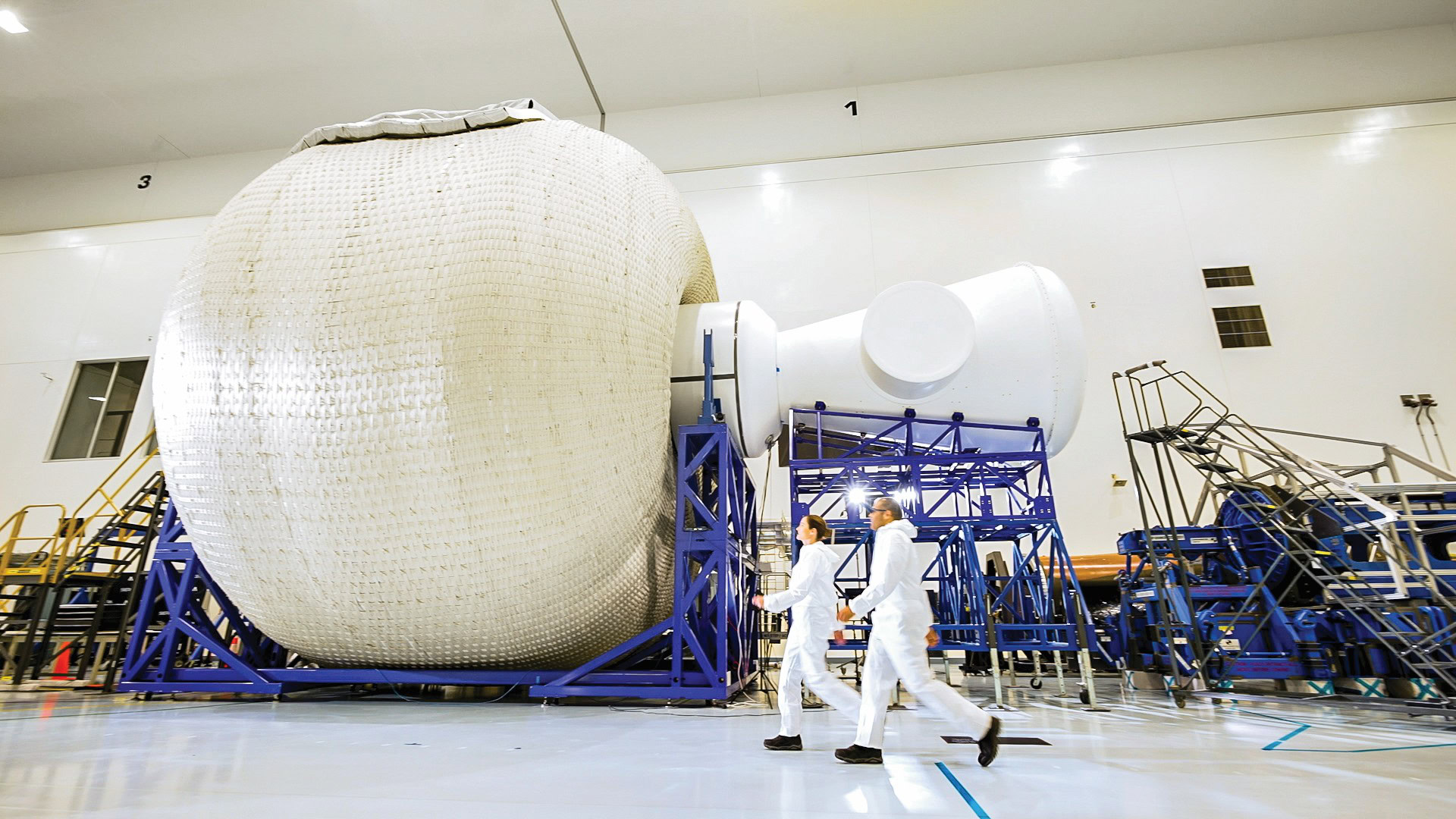
Figure 8. Full-scale prototype of the LIFE habitat. Credit: Sierra Space
Early products coming out of Sierra Space facilities will likely be small pieces of technical equipment that could most benefit from space-based construction. The finer and more miniaturized a piece of technology is, the greater the impact a single flaw has on its functionality, explains Jonathan Volk, senior manager of in-space manufacturing and advanced materials for Sierra Space, in an interview.
For example, manufacturing a graphene-based semiconductor could involve laying down the carbon via a chemical vapor deposition process. Any hiccups or jolts during the deposition process could impact the semiconductor functionality because the graphene is one atomic-layer thick. As it turns out, the wafer-thin goods that could most benefit from flawless production also make for lightweight and relatively inexpensive payloads.
Booming growth in the communications technologies market makes it an appealing sector for manufacturing development as well. The previously mentioned fiber optics market is set to reach $13.7 million by 2026, nearly 40% higher than the same market in 2022.3 Graphene semiconductors could reach a market value of about $70 million by 2030.54
The LIFE habitat, which will combine living quarters, a kitchen, a garden, and production space, will account for about 80% of the volume of the ISS and could possibly manage crystal growth and ceramic stereolithography. Down the line, other more energy-intensive processes might become part of the Sierra Space offerings, such as furnaces similar to the one JAXA runs on the ISS.
“The idea of supporting a furnace that can reach any melting point of any material known to man at this point is going to have some design challenges,” Volk says in an interview.
Returning to Earth
When a given mission, whether experiment or expedition, is complete, spacecrafts often will return to Earth. During reentry, the vehicle exterior reaches extreme temperatures due to adiabatic compression and friction.
Early spacecraft relied on sacrificial, or “ablative,” layers to withstand these temperatures, for example, the Apollo series of spacecraft featured ablative heat shields. These layers consisted of materials that vaporized upon extreme heating, helping to deflect and carry away the heat.55 Most ablative materials are made of polymers, sometimes with fiberglass reinforcement, but the foundation supporting the ablative portion can be ceramic based, says Peter Marshall, research scientist with Analytical Mechanics Associates (AMA) Incorporated working with the Thermal Protection Materials branch at NASA Ames, in an interview.
Some form of ablative material will be on the Mars Sample Return Earth Entry Vehicle. The job of this particular craft is spelled out in its name: to bring samples of Mars’ surface, as collected by the Perseverance rover, back for research.56
One candidate ablative system is the 3D Medium Density Carbon Phenolic (3DMCP). This particular mission is looking for an ablator with higher density and more mechanical strength, which the engineering team thinks will likely be found in the woven structure of 3DMCP.
“I think that these 3D weaves for carbon fiber really also leveraged a lot of our best past experience for pre-woven C/SiC or C/C or some of the other full ceramic systems,” Marshall says.
The thickness of the 3DMCP and the kind of matrix embedded in the fibers can be customized for each application, which is a departure from standard materials that change little but are applied to a range of projects.
“We’re heading in the direction of being able to tailor TPS. So rather than a monolithic, we may have a multilayer TPS material, depending on mission needs,” says Mairead Stackpoole, chief of the Thermal Protection Materials Branch of NASA Ames, in an interview.
Nowadays, creating reusable shuttles is a focus for government and privately funded aerospace initiatives. As such, materials that can withstand repeated exposure to extremely high temperatures without burning up are needed, and ultrahigh-temperature ceramics are one solution (see sidebar: Ultrahigh-temperature ceramics ‘lead’ the way in hypersonic vehicle development).
The reentry period also serves as an invaluable opportunity to collect data on what exactly a craft is exposed to as it careens back through our atmosphere.
“Those environments cannot be fully replicated on the ground with our test facilities,” says Jose Santos, aerospace flight systems engineer in the Thermal Protection Materials Branch of NASA Ames, in an interview.
When it comes to researching what a potential reentry system might look like, the gold standard simulation is a model that predicts environmental conditions based on real-life measurements collected during flight. Ceramic-based TPS components can ensure the readings captured on reentry are accurate.
For example, reentry temperature measurements are often made with onboard thermocouples (Figure 9). To ensure the highest-quality temperature reading possible, the wires may be sheathed in ceramic tubes that are typically 99% or more alumina, Santos says.
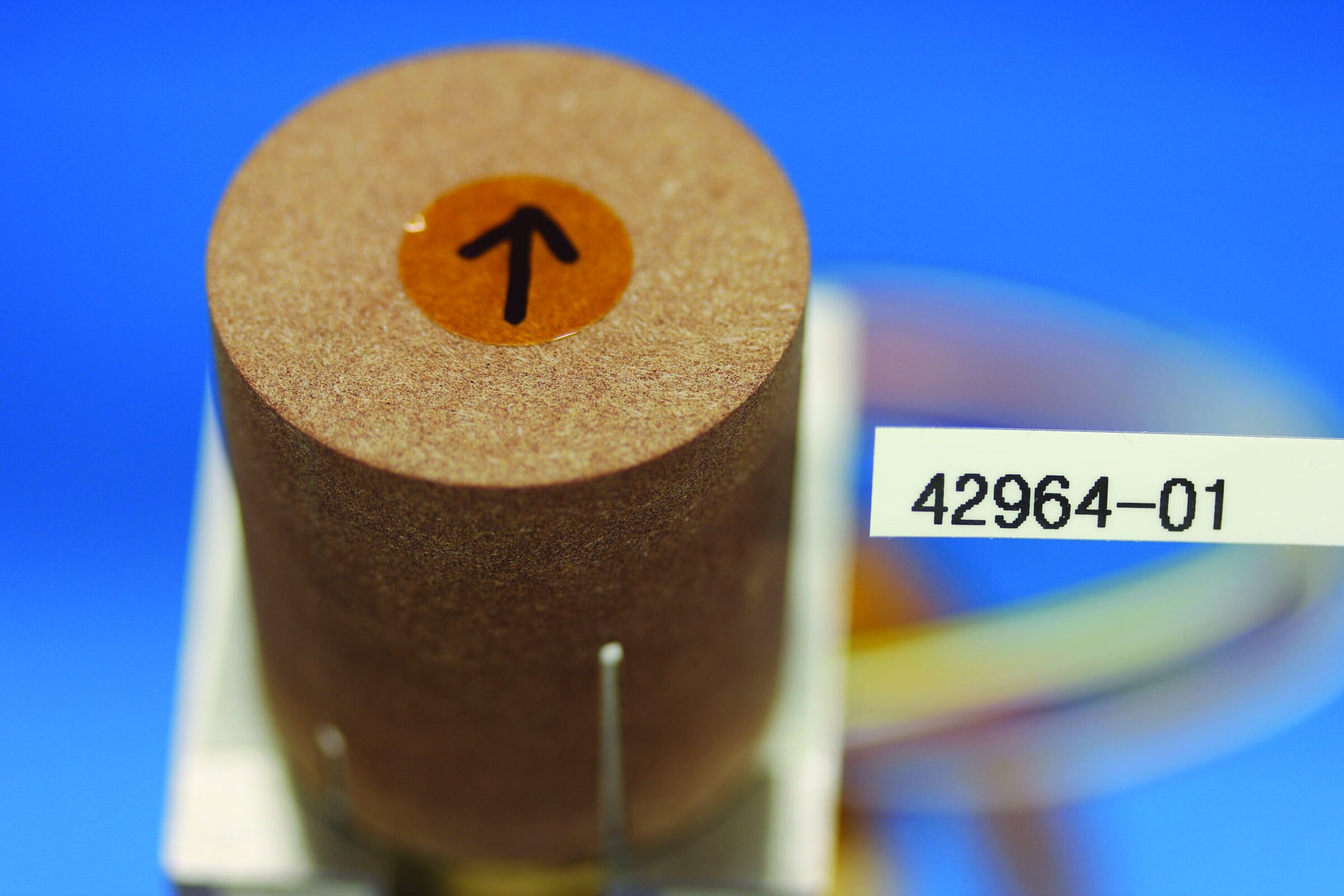
Figure 9. Heat shield thermocouple plug with ceramic insulator along the sidewall. Credit: NASA
Recently, Santos and his colleagues looked to further miniaturize the thermocouples and their insulator systems to increase accuracy and reduce footprint. Additive manufacturing technologies might be the solution, although so far, finding a supplier has proved challenging, Santos says.
Staying in space: Moon bases, Mars colonies, and beyond
Even in the instances where a mission will not return to Earth, ceramics are key to developing spacecrafts that can go the distance and keep people functioning on other planets (Figure 10).
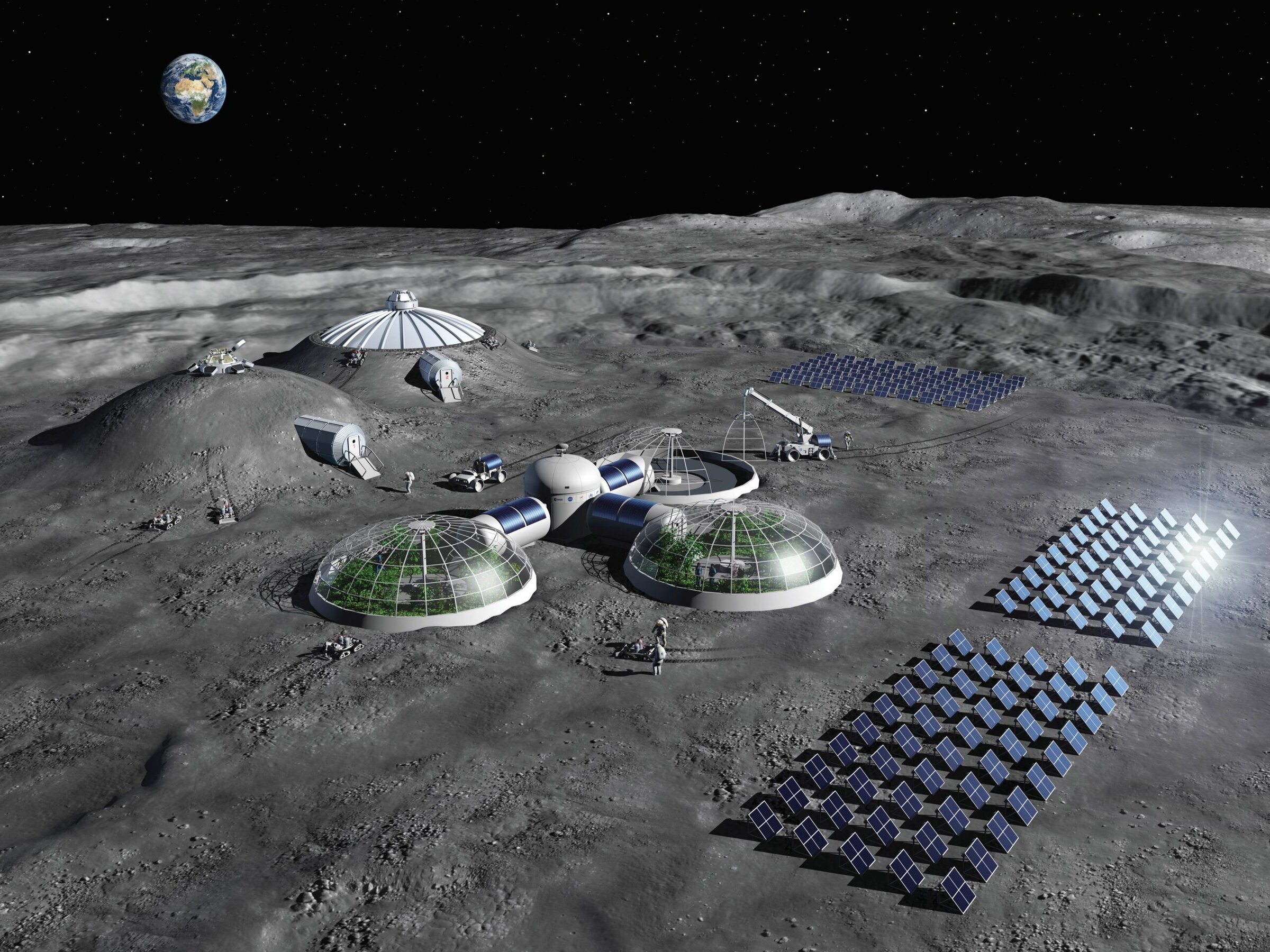
Figure 10. Artist impression of a lunar base concept, featuring solar arrays for energy generation, greenhouses for food production, and habitats shielded with regolith. Credit: P. Carril, ESA
Both NASA and ESA are investigating moon bases where astronauts would live for longer periods on the lunar surface. But an extended stay requires supplies and equipment—everything from housing to tools to replacement vehicle parts. What if components were made from regolith, the surface material covering whatever satellite rock or planet humans are on? If that were possible, missions could launch smaller payloads, and the raw material certainly would be plentiful.
“For Mars, it is not only a wish, but it’s almost a necessity,” says Advenit Makaya, advanced manufacturing engineer at the European Space Research and Technology Centre of the European Space Agency, in an interview. “It takes a long time to go there and takes a long time to come back. You want to make the most of the time you have there.”
The need to produce components in space pushes companies and space agencies to test different manufacturing methods with simulated regolith. Missions to potential base areas show that the minerals on extraterrestrial surfaces are fairly similar to what is on Earth, save differences in proportions and chemical compositions, Makaya says.
But in-space manufacturing will lack the mineral refinement processes we use on Earth. Mining and purifying regolith would consume too much energy and infrastructure. Besides, any water found on the planets will have to be dedicated to more pressing needs such as human consumption or fuel production, not manufacturing. Any astronauts assembling components and structures from regolith will be working with essentially raw material and all its varieties and complexities.
While terms like “lunarcrete” might be thrown around to communicate the intended purpose or durability of regolith products, Makaya says vocabulary meant to make extraterrestrial construction sound like Earth-based construction materials will never be a perfect fit.
For now, researchers working with simulated regolith use renditions mimicking specific attributes of the complex original. Work concerned with seismic activity will study a simulant focused on replicating particle size distribution, Makaya says, while experimentation with a manufacturing process that essentially aims to melt the regolith into a kind of glass will rely on a mockup with the right chemical composition.
Makaya and his ESA colleagues studied simulated regolith alongside Lithoz, a 3D ceramics printing company. More specifically, the team tested lithography-based ceramic manufacturing with a regolith simulant developed by the European Astronaut Center,57 containing ingredients such as silicon dioxide, aluminum oxide, and calcium oxide (Figure 11).58 The production process involves a mixed ceramic and polymer material that is 3D printed.59 The polymer acts as a kind of glue that keeps ceramic particles together. Debinding, or the burning out, of the polymer leaves behind a ceramic structure that needs sintering to completely densify. The sample screws, nuts, and bolts the ESA and Lithoz team printed were too fragile, Makaya says, but the team is investigating alternative applications such as mesh screens or filters.
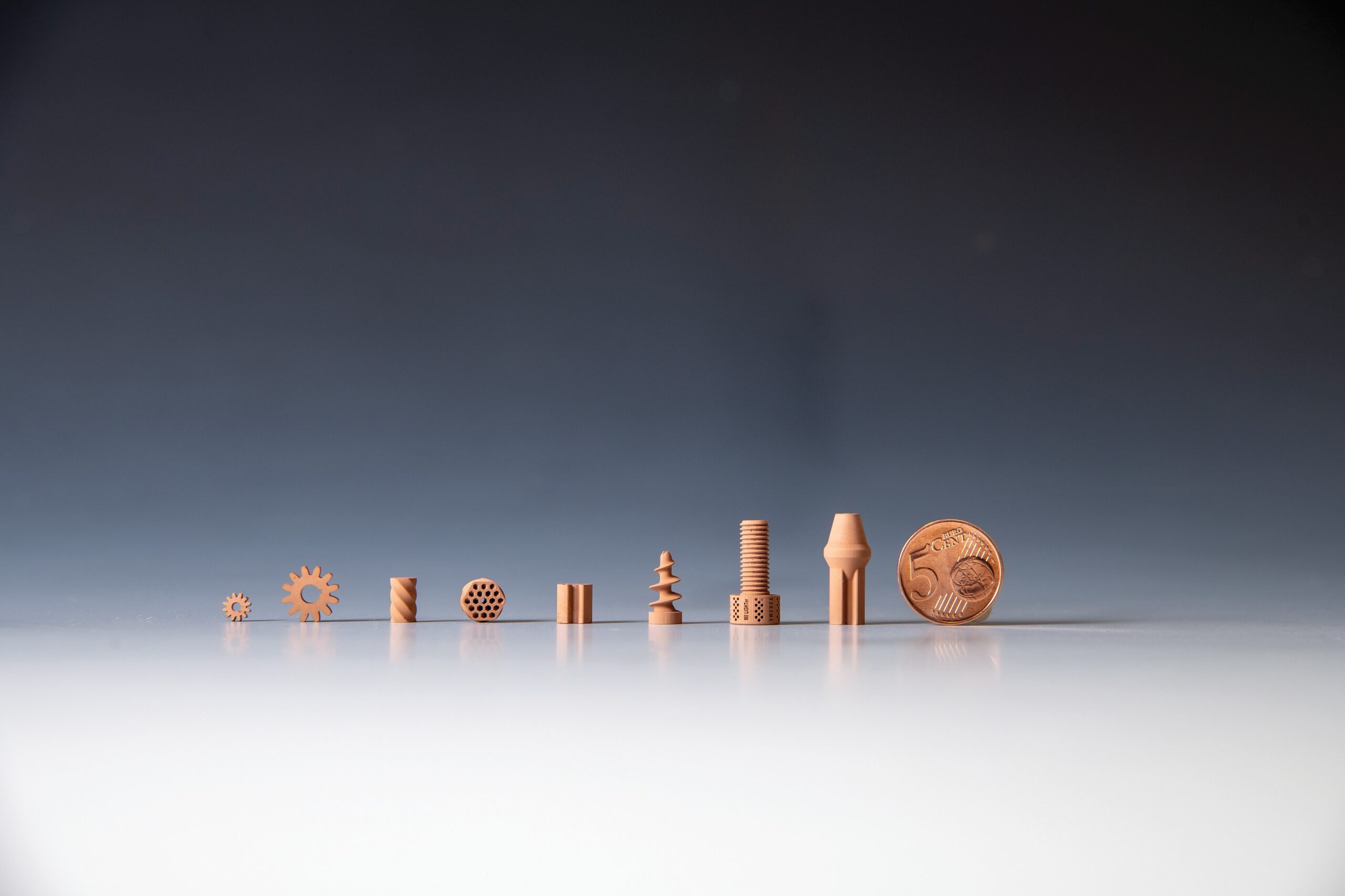
Figure 11. Finely detailed ceramic parts that were 3D printed using simulated lunar regolith. The European Space Agency and Lithoz collaborated to investigate how 3D printing could be used to support a lunar base. Credit: European Space Agency
‘Space’ for Exploration
As the timelines and production schedules of various missions indicate, space missions take years and even decades to execute. The money and testing required to get people and equipment farther than ever before takes time—but when information such as the exact mineral composition of Earth’s only satellite or the precise depth of a far-away planet’s gassy clouds come back to us, the investment in carefully assembling spacecrafts and space equipment is worth it. The far-flung gear is, in a way, extensions of ourselves. It serves essentially as our ears, eyes, hands, noses, and mouths in new places.
Even if it takes decades (or longer) for humans to set foot on these far-off places, we can thank glass and ceramics for getting there first and helping make each extreme environment that much more intriguing and accessible.
Global markets for ceramics in space
Expanding space programs and operations, including the current commercial space travel boom, ensure a strong future for ceramic space markets. For North America alone, the market for space operation ceramics was valued at $158.2 million in 2020 and is predicted to reach $902.9 million in 2026.
Though North America, the United States in particular, represents the largest space ceramic market, other global markets are growing as well. European, Asian-Pacific, and Chinese markets should reach $473.7 million, $438 million, and $150.4 million by 2026, respectively. Learn more about these markets in the “Busi-ness and Market View” column.3
Read more: “Chalcogenide phase-change materials: Changing our approach to aerospace photonics“
Read more: “Ultrahigh-temperature ceramics ‘lead’ the way in hypersonic vehicle development“
Read more: “Cleaning up our atmosphere: Tackling the issue of space debris“
Read more: “Corning’s contributions to space technology“
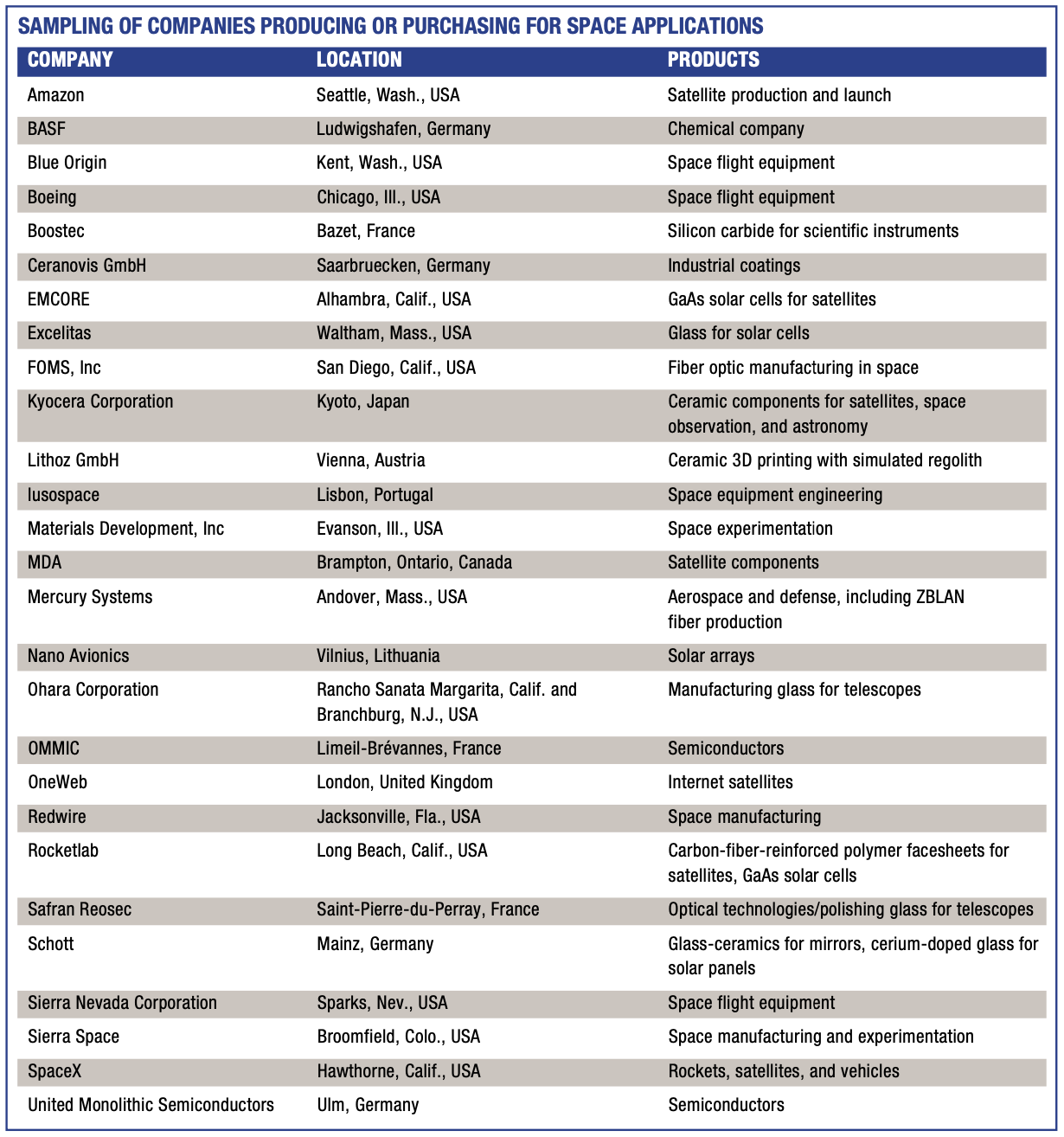
Cite this article
L. Nemo, “Star power! How glass and ceramics push us deeper into space,” Am. Ceram. Soc. Bull. 2022, 101(9): 19–32.
Issue
Category
- Electronics
- Engineering ceramics
- Glass and optical materials
- Manufacturing
Article References
1“Galileo and the telescope.” From the Library of Congress collection Finding our place in the cosmos: From Galileo to Sagan and beyond. https://www.loc.gov/collections/finding-our-place-in-the-cosmos-with-carl-sagan/articles-and-essays/modeling-the-cosmos/galileo-and-the-telescope
2Gocha, April. “Peering into the past: What early telescopes reveal about glass technology and scientific evolution.” The American Ceramic Society Bulletin, Vol. 94, No. 4
3BCC Publishing Staff. “Fiber optic instrumentation market.” BCC Publishing, March 2022.
4Sharp, Tim, and Doris Elin Urrutia. “What is the temperature on the Moon?” Space.com, Space, 28 Feb. 2022, https://www.space.com/18175-moon-temperature.html
5“NASA developing new heat shield for Orion.” NASA, 13 Sept. 2006.
6LEO. The European Space Agency, 2 March 2020.
7Woods, Tori. Out of thin air. NASA, 17 Feb. 2011.
8Tran, Linda. “How NASA prepares spacecraft for the harsh radiation of space.” NASA, 10 June 2019.
9“Space faring the radiation challenge: An interdisciplinary guide on radiation biology for grades 9 through 12.” Module 3: Radiation countermeasures. NASA.
10Lauenstein, Jean-Marie et al. “Space radiation effects on SIC power device reliability.” NASA. https://nepp.nasa.gov/docs/tasks/045b-Power-Devices-Wide-Bandgap-
Silicon-Carbide-Power-Devices/NEPP-CP-2021-Lauenstein-Paper-IRPS-SiC-Power-Device-Reliability-20210010338.pdf
11“What was the Apollo 11 heat shield made of?” Apollo11Space. https://apollo11space.com/what-was-the-apollo-11-heat-shield-made-of
12“FAQ.” UA Science Richard F. Caris Mirror Laboratory. https://mirrorlab.arizona.edu/content/faq
13Clery, Daniel. “Giant Magellan Telescope gets green light for construction.” Science, 4 June 2015.
14The Giant Magellan Telescope. Smithsonian Global.
15Schott produces 500th M1 primary mirror segment for Extremely Large Telescope. Schott, 13 July 2022.
16“About.” European Southern Observatory. 2022.
17“Micrometeoroids and space debris.” NASA STEM engagement. 1998.
18X-37B orbital test vehicle. Official United States Air Force, August 2020.
19Johnson, Syliva M. “Coatings and surface treatments for reusable entry systems.” NASA Ames Research Center, 7 March 2016.
20“Coatings.” Thermal Protection Materials Branch. NASA, 20 May 2019.
21Roulette, Joey. “Japanese company joins march back to the moon in 2022.” The New York Times, 25 Jan. 2022.
22“As Artemis moves forward, NASA picks SpaceX to land next Americans on Moon.” NASA, 16 April 2021.
23Calle, Luz, et al. “Refractory materials for flame deflector protection.” AIAA SPACE Forum, 26 June 2012, https://arc.aiaa.org/doi/abs/10.2514/6.2010-8749
24Launch complex 39, Pads A and B. NASA Facts, NASA.
25Iemole, Anthony. “Kennedy Space Center expands as Launch Complex 48 opens for operations.” Nasaspaceflight.com, 22 Dec. 2020.
26Lays, Edward J., and Eugene A. Darrow. “Effects of exhausts from aluminized solid propellants on launch facilities.” Journal of Spacecraft and Rockets, vol. 4, no. 7, 1967, pp. 934–940, https://doi.org/10.2514/3.59554
27@elonmusk. “About 2 secs after starting engines, martyte covering concrete below shattered, sending blades of hardened rock into engine bay. One rock blade severed avionics cable, causing bad shutdown of Raptor.” Twitter, 17 Nov. 2020, 11:49 AM.
28Our vehicle. Orbex Space. 2022.
29“In final countdown to UK rocket launch, Orbex to hire fifty new staff over next six months.” Satnews, 24 Aug. 2022.
30Schroeder, Stan. “SpaceX’s Starlink internet is now available in 32 countries.” Mashable, 13 May 2022.
31Nehls, Grace. “Beyond Gravity receives major Amazon contract for scalable CFRP dispenser systems.” CompositeWorld, 13 June 2022.
32“What powers a spacecraft?” NASA Science Space Place, 30 Aug. 2022.
33E. A. Plis et al., “Effect of simulated GEO environment on the properties of solar panel cover glasses,” in IEEE Transactions on Plasma Science, vol. 49, no. 5, pp. 1679–1685, May 2021, doi: 10.1109/TPS.2021.3070196.
34Lamb, DA, Irvine, SJC, Baker, MA, Underwood, CI, Mardhani, S. “Thin film cadmium telluride solar cells on ultrathin glass in low earth orbit—3 years of performance data on the AlSat-1N CubeSat mission.” Prog Photovolt Res Appl. 2021; 29: 1000–1007. https://doi.org/10.1002/pip.3423
35Reyes, Jacqueline A. et al. “Spectroscopic behavior of composite, black thermal paint, solar cell, and multilayered insulation materials in a GEO simulated environment,” NASA. https://ntrs.nasa.gov/api/citations/20190033943/downloads/20190033943.pdf
36“SolAero Technologies’ solar panel powers NASA’s Mars helicopter – Ingenuity.” SolAero Technologies Corp, 19 April 2021.
37Ceruzzi, Paul. “Apollo guidance computer and the first silicon chips.” 14 Oct 2014.
38Neudeck, Philip G. et al. “Prolonged silicon carbide integrated circuit operation in Venus surface atmospheric conditions.” AIP Advances, vol. 6, no. 12, 2016, p. 125119, https://doi.org/10.1063/1.4973429
39Sequeira, M.C., Mattei, JG., Vazquez, H. et al. “Unravelling the secrets of the resistance of GaN to strongly ionising radiation.” Commun Phys 4, 51 (2021). https://doi.org/10.1038/s42005-021-00550-2
40“Going GaN: novel chips powering space missions.” ESA, 14 June 2022.
41“Benefits, silicon carbide electronics and sensors.” NASA, 18 Oct. 2021.
42Anthony, Sebastian. “We finally have a computer that can survive the surface of Venus.” ArsTechnica, 8 Feb. 2017.
43Philip G. Neudeck, Roger D. Meredith, Liangyu Chen, David J. Spry, Leah M. Nakley, and Gary W. Hunter, “Prolonged silicon carbide integrated circuit operation in Venus surface atmospheric conditions,” AIP Advances 6, 125119 (2016), https://doi.org/10.1063/1.4973429
44Mantooth, Alan et al. “The radio we could send to Hell.” IEEE Spectrum, 1 June 2022, https://spectrum.ieee.org/the-radio-we-could-send-to-hell
45Jacques Breysse, Didier Castel, and Michel Bougoin. “All-SiC telescope technology at EADS-Astrium.” Mersen Issue 04. https://www.mersen.us/sites/us/files/publications-media/icso-2012-all-sic-telescope-technology-at-eads-astrium-boostec-mersen.pdf
46Witze, Alexandra. “Astronauts have conducted nearly 3,000 science experiments aboard the ISS.” Nature. 3 Nov. 2020.
47“Alumni of influence: Delbert Day: glass master and cancer fighter.” Missouri S&T. https://influence.mst.edu/2011/delbertday
48“Utilization of electrostatic levitation furnace (ELF) has been started to obtain thermophysical properties of high-temperature melts.” 23 Oct. 2018. Japanese Aerospace Exploration Agency.
49“Materials research for space and in space: Rick Weber,” Ceramic Tech Chat, 10 Aug. 2022.
50“NASA-supported optical fiber manufacturing arrives at Space Station.” NASA, 18 July 2022.
51“Ceramics manufacturing module.” Redwire. 2022.
52Matthews, Jennifer. “Concrete in space.” PennState, 23 Jan 2019.
53“NASA provides updated International Space Station Transition Plan.” NASA, 31 Jan 2022.
54Batra, Gaurav, Santhanam, Nick, Surana, Kushan. “Graphene: The next S-curve for semiconductors?” McKinsey and Company, 10 April 2018.
55Sundén, Bengt, Fu, Juan. “Ablation. Heat transfer in aerospace applications.” 2017. https://www.sciencedirect.com/book/9780128097601/heat-transfer-in-aerospace-applications
56“Mars sample return.” Jet Propulsion Laboratory California Institute of Technology.
57Altan Alpay Altun, Florian Ertl, Maude Marechal, Advenit Makaya, Antonella Sgambati, Martin Schwentenwein, “Additive manufacturing of lunar regolith structures,” Open Ceramics, Volume 5, 2021, 100058, ISSN 2666-5395, https://doi.org/10.1016/j.oceram.2021.100058
58Oney, Faye. “3D-printed ceramic parts could support lunar colonies.” Ceramic Tech Today, The American Ceramic Society, 23 Nov. 2018.
59“Webinar | LMT Lab Day 2020 – LCM as a tool for fully digital workflow.” YouTube, uploaded by Lithoz GmbH, 6 Nov. 2020.
Related Articles
Market Insights
Lessons learned from the rollout of 5G technology help guide 6G preparations
While it may seem like the 5G communications and data network has just been rolled out—and is, in fact, still in the process of being deployed—communications providers, governments, and researchers are already preparing for the sixth generation of wireless technology, or 6G. Compared to 5G, which aimed to expand the…
Bulletin Features
The synthetic data revolution: How AI is redefining quality control in ceramics manufacturing
The ceramics industry stands at the brink of a fundamental shift in how quality control is conceived, implemented, and scaled. For decades, the promise of artificial intelligence-powered inspection systems was held back by a persistent obstacle: the scarcity of high-quality data. This bottleneck made it difficult for ceramics manufacturers to…
Market Insights
Global edge AI market
The global market for edge artificial intelligence was valued at $8.7 billion in 2024 and is expected to grow at a compound annual growth rate (CAGR) of 36.9% to reach $56.8 billion by the end of 2030. Edge computing refers to data processing that occurs closer to where the data…
